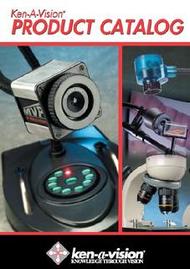Choosing a MicroscopeProviding quality microscopes for education is our expertise at Scientific Specialties. As an authorized national distributor for leading microscope manufacturers, we can help provide you with quality microscopes that are just right for you! Our exclusive e-Catalogs below feature broad selections and the necessary information for you to make the right choice for your program.
|
Features
|
Buy 10, Get 2 FREE
Specials like this may be found throughout our product offering for most "like items", providing exceptional value to educators. Contact us for product recommendations, quotations, or proposals.
Our Seven-Star Selection Process
- At what grade level / in what courses will these scopes be used?
- What do you intend to observe with these microscopes? Bacteria? etc?
- Will you observe items other than those seen on a microscope slide, such as opaque items?
- Will you use these microscopes for field observations outside of the classroom?
- Rank, 1 to 5, these selection criteria: Value, Price, Quality, Lifetime Warranty, and Opteration.
- How many students do you have in your largest class?
- Do you have a set budget for these microscopes?
e-Catalogs
Ken-A-Vision
|
More coming soon! |
More coming soon! | ||||||
Representing these Quality Manufacturers
Microscope Selection Guide
Whether you are purchasing new microscopes to replace old ones or to expanding your biology program, you may find ask yourself, “Where do I begin?” We are happy to help narrow your selection to those types of microscopes that best you’re your specific teaching and learning needs with your students and those that are right for your science classroom or laboratory.
There are 2 basic types of microscopes: Stereomicroscopes and Compound microscopes.
Stereomicroscopes
Stereomicroscopes, or commonly referred to as dissecting microscopes, offer low-power magnification within a wide field of view. These microscopes are ideal for macroscopic discovery with your students. Each may be used to observe specimens such as rocks, fossils, macro-organisms, insects, plant and animal specimens, circuit boards, and the like. Stereomicroscopes usually have a binocular head.
Most stereomicroscopes are offered with lighted illumination above the stage for opaque objects and below the stage for translucent specimens, or both. Unlike compound microscopes, the specimens do not need to be prepared in thin sections – thin enough for light to pass through from below.
Specimens viewed through a stereomicroscope appear three dimensional. Total magnification usually ranges from 10× to 40×. Similar to the compound microscope, magnification is accomplished by the combination of the eyepiece lens and the objective lens in the nosepiece.
Compound microscopes
Compound microscopes are the most popular type of microscope, offering high magnification and a narrow field of view. These microscopes are ideal for microscopic discovery of the “hidden world” of protozoa, algae, bacteria, cells and cell structure. To observe these types of specimens, preparation of specimens is required. Light is transmitted through the specimen with the use of a compound lens and therefore requires preparation of the specimen on a slide. Specimens must be mounted on a glass or plastic slide prior to viewing. Compound microscopes have acquired the reference to the “compounding of lenses” built up in the microscope objectives that allow for significant magnification.
Slides to be viewed are placed on the microscope’s stage and illuminated by light from below the stage. Magnification usually ranges from 40x to 1,000x, and is accomplished by the combination of the microscope’s eyepiece lens and one of its objective lenses located in the rotating nosepiece. The total magnification is derived when the ocular (eyepiece) magnification is multiplied by the objective magnification. For example, a 10x eyepiece and a 40x objective provide a total magnification of 400x.
Compound microscopes are available with monocular (one eyepiece), binocular (2 eyepiece), and trinocular (3 eyepiece) heads. Monocular compound microscopes are suitable for work by most beginning students (upper elementary through high school). Binocular compound microscopes are suited for work in more advanced levels (advanced high school and college). Trinocular compound microscopes enable binocular viewing with a separate eyepiece for cameras or other imaging devices.
A graduated mechanical stage is an essential accessory for compound microscopes used in high school and college classes. It allows the student to position the slide precisely in the field of view. This makes it possible to perform measurements and to examine the entire specimen in detail.
Other microscope components enhance the viewing of specimens. An Abbe condenser is positioned below the stage and is used to concentrate light on your prepared specimen. A diaphragm also positioned below the stage regulates the amount of light allowed to the specimen. Light sources vary among microscope models and include LED, halogen, fluorescent, tungsten or mirrors. Most manufacturers offer the lighting that best suits their microscope application.
A microscope is a viewing system and the quality of a microscope viewing is affected by each and every components. Since microscopes represent a significant investment, be certain you are specifying the quality that will be appreciated by users for years to come.
Provided courtesy of Scientific Specialties, Inc.
There are 2 basic types of microscopes: Stereomicroscopes and Compound microscopes.
Stereomicroscopes
Stereomicroscopes, or commonly referred to as dissecting microscopes, offer low-power magnification within a wide field of view. These microscopes are ideal for macroscopic discovery with your students. Each may be used to observe specimens such as rocks, fossils, macro-organisms, insects, plant and animal specimens, circuit boards, and the like. Stereomicroscopes usually have a binocular head.
Most stereomicroscopes are offered with lighted illumination above the stage for opaque objects and below the stage for translucent specimens, or both. Unlike compound microscopes, the specimens do not need to be prepared in thin sections – thin enough for light to pass through from below.
Specimens viewed through a stereomicroscope appear three dimensional. Total magnification usually ranges from 10× to 40×. Similar to the compound microscope, magnification is accomplished by the combination of the eyepiece lens and the objective lens in the nosepiece.
Compound microscopes
Compound microscopes are the most popular type of microscope, offering high magnification and a narrow field of view. These microscopes are ideal for microscopic discovery of the “hidden world” of protozoa, algae, bacteria, cells and cell structure. To observe these types of specimens, preparation of specimens is required. Light is transmitted through the specimen with the use of a compound lens and therefore requires preparation of the specimen on a slide. Specimens must be mounted on a glass or plastic slide prior to viewing. Compound microscopes have acquired the reference to the “compounding of lenses” built up in the microscope objectives that allow for significant magnification.
Slides to be viewed are placed on the microscope’s stage and illuminated by light from below the stage. Magnification usually ranges from 40x to 1,000x, and is accomplished by the combination of the microscope’s eyepiece lens and one of its objective lenses located in the rotating nosepiece. The total magnification is derived when the ocular (eyepiece) magnification is multiplied by the objective magnification. For example, a 10x eyepiece and a 40x objective provide a total magnification of 400x.
Compound microscopes are available with monocular (one eyepiece), binocular (2 eyepiece), and trinocular (3 eyepiece) heads. Monocular compound microscopes are suitable for work by most beginning students (upper elementary through high school). Binocular compound microscopes are suited for work in more advanced levels (advanced high school and college). Trinocular compound microscopes enable binocular viewing with a separate eyepiece for cameras or other imaging devices.
A graduated mechanical stage is an essential accessory for compound microscopes used in high school and college classes. It allows the student to position the slide precisely in the field of view. This makes it possible to perform measurements and to examine the entire specimen in detail.
Other microscope components enhance the viewing of specimens. An Abbe condenser is positioned below the stage and is used to concentrate light on your prepared specimen. A diaphragm also positioned below the stage regulates the amount of light allowed to the specimen. Light sources vary among microscope models and include LED, halogen, fluorescent, tungsten or mirrors. Most manufacturers offer the lighting that best suits their microscope application.
A microscope is a viewing system and the quality of a microscope viewing is affected by each and every components. Since microscopes represent a significant investment, be certain you are specifying the quality that will be appreciated by users for years to come.
Provided courtesy of Scientific Specialties, Inc.











